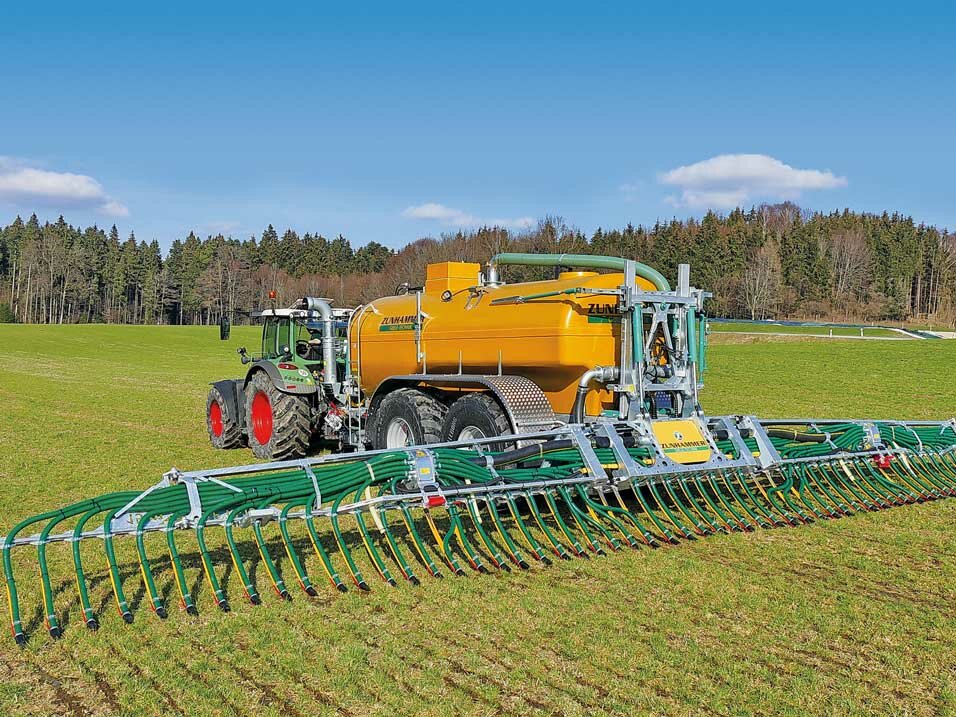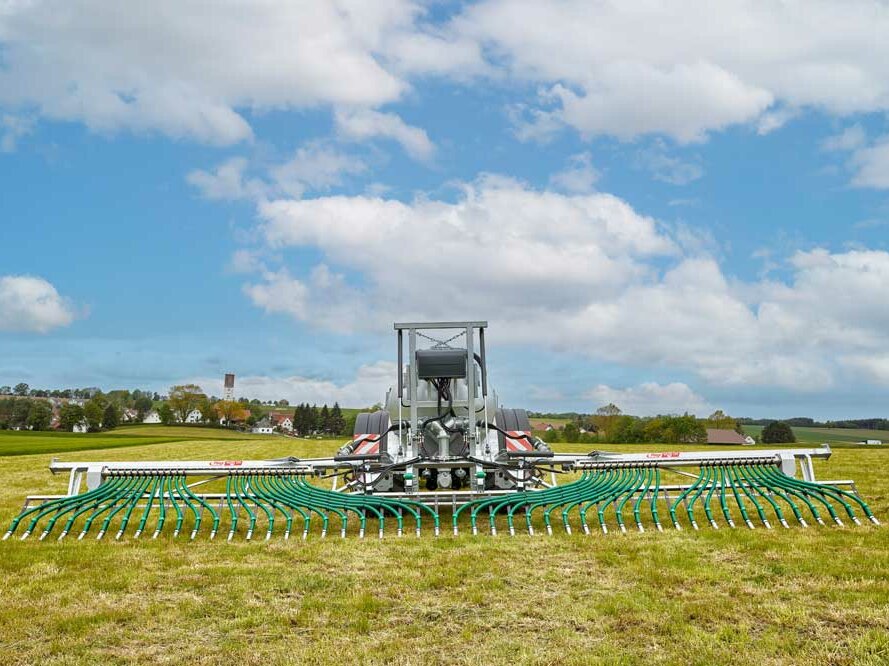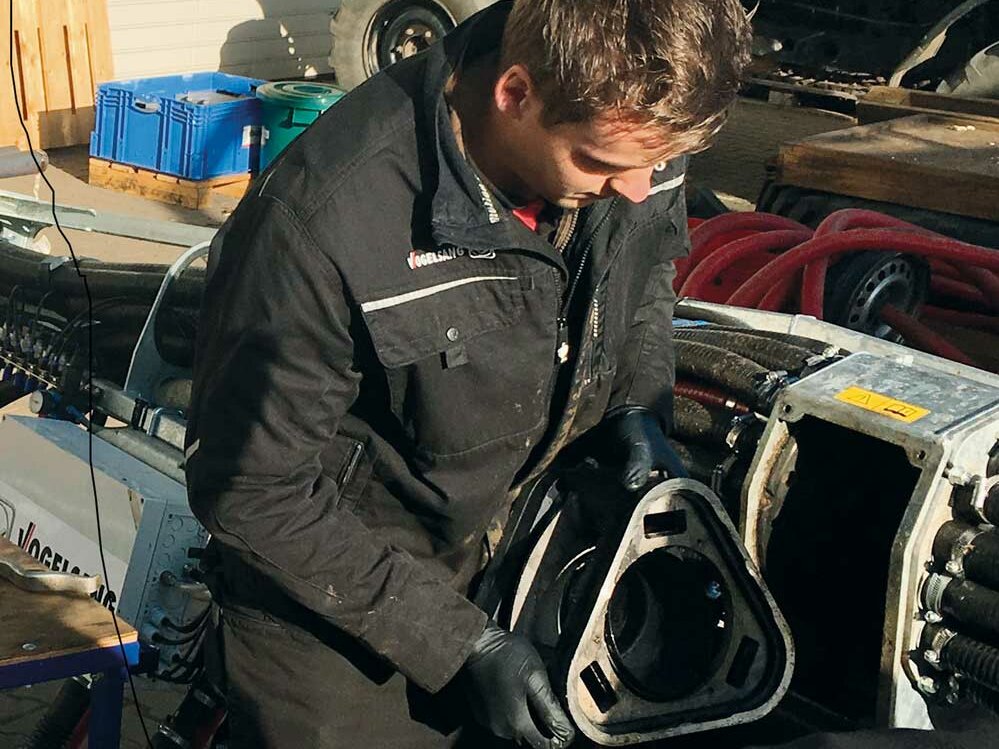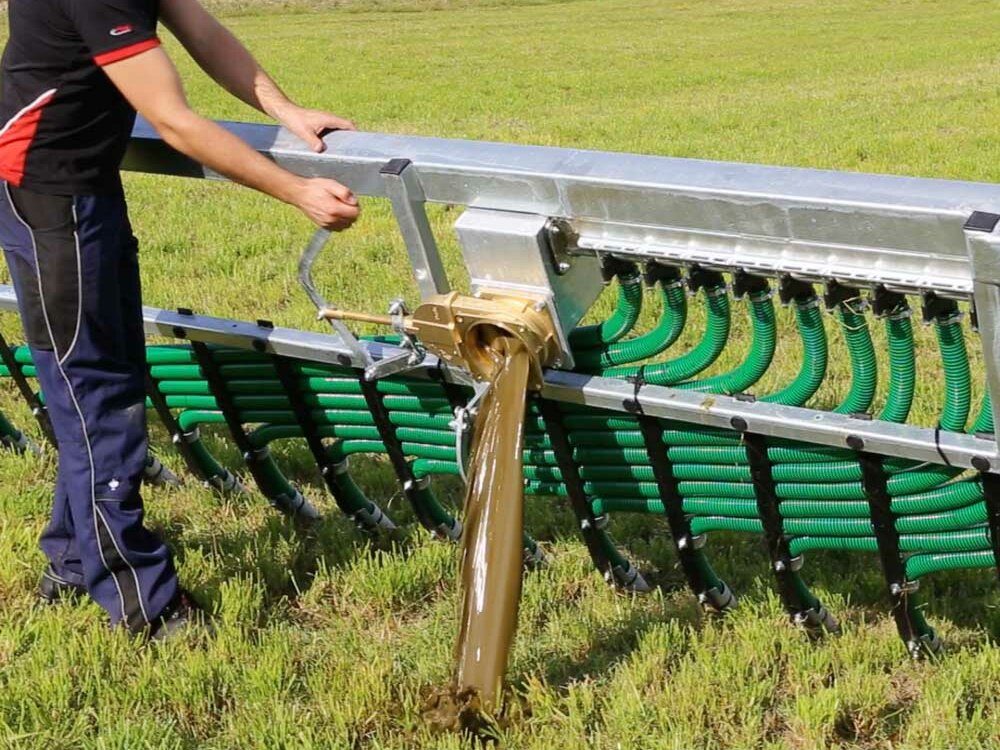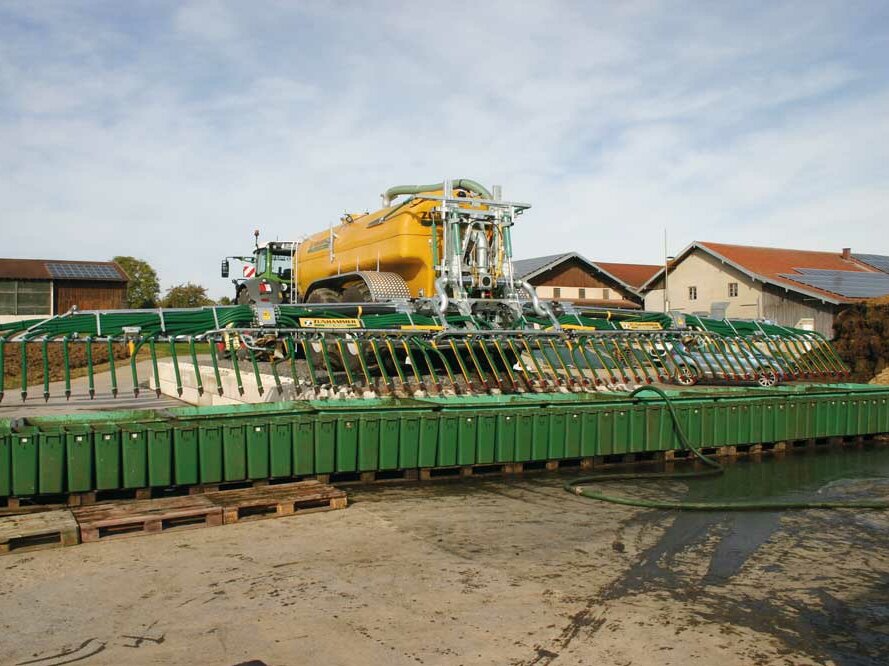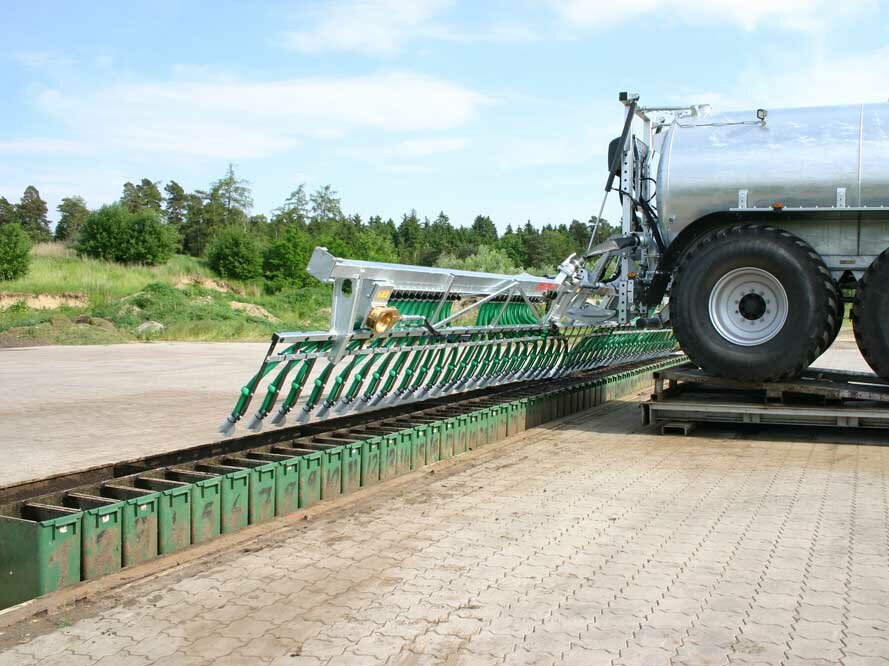Slurry spreading: Optimal cross-distribution
By Georg Horst Schuchmann, DLG Test Center Technology and Farm Inputs
Keeping an eye on the working width
Comment by Georg Horst Schuchmann
The lateral distribution is an important criterion for evaluating a slurry spreader. However, if you want to evaluate it, you have to keep an eye on the working width. With the mobile test stand of the DLG test center, the slurry is collected and weighed separately under each diffuser after the end of the start-up phase (until slurry appears at all outlets). Subsequently, the statistical key figures "Mean deviation" and "Coefficient of variation" are calculated and evaluated. In total, this test consists of four parts, because it is carried out with two types of slurry (with low and high dry matter content) and one high and one low application rate each (20 and 40 m³/ha). How evenly the distribution is made over the working width depends on various factors. These factors include the characteristics of the slurry as well as the application rates, i.e. the volume flows applied to the distributor, and the working pressure, which are therefore also recorded for each test. However, due to physical conditions, distribution uniformity often also decreases as the number of outlets per distributor head increases. In the past, for example, major differences have become apparent between distributors of the same design from the same manufacturer with different working widths, and these differences must be taken into account when evaluating and comparing the results. The following applies: These jumps in quality between a smaller and a larger working width can have a negative effect if, for example, distributors with more outlet openings are used. But changes for the better are also possible if one or two additional, smaller distributors are installed as the working width increases. When purchasing DLG-tested slurry technology, it should therefore be noted that the DLG test mark awarded refers exclusively to the tested product in the specified working width.
The challenge is clear: in low-emission, ground-level slurry application, the slurry must be distributed evenly to all outlets. And this is independent of the working width, which on the market ranges from less than 6 m for small booms to up to 36 m for large booms. With the latter, several distribution systems are then needed in parallel to supply the up to 120 hoses.
In addition to many other new regulations, the current fertilizer ordinance in Germany also defines requirements for the technology: On cultivated arable land, liquid organic fertilizers that contain a significant amount of available nitrogen, such as liquid manure, have had to be applied in strips or directly into the soil since last year. For grassland, these requirements will apply from 2025. Comparative data show that this technology actually also promotes low-emission application. A drag shoe spreader, for example, can prevent between 40% (cattle slurry) and 60% (pig slurry) of emissions compared to spreading with an impact plate or swivel spreader. At the same time, placing the slurry belt on the ground in the split emergence helps prevent contamination of the crop.
Drag shoe linkage in the DLG test
Fliegl offers its drag shoe boom "Skate" in working widths of 6 meters, 7.5 meters, 9 meters, 12 meters, 15 meters, 18 meters, 21 meters and 24 meters. What all the booms have in common is that at Fliegl - in contrast to other manufacturers - it is not a knife distributor, but for more than 20 years now its own patented auger distributor that ensures the even feeding of the hoses or drag shoes.
The Zunhammer GlideFix drag shoe boom is offered with working widths of 12 m, 15 m and 18 m. In the tested 15 m version, the hose spacing is 25 cm. When folded, the boom, which can be attached by direct attachment or via a 4-point linkage, has a transport width of 2.98 m. The boom has an integrated safety gear and passive pendulum compensation in the center frame. Part-width section control is possible manually or hydraulically, and pneumatic valves can be used to switch the outlets on and off in 1.5-meter increments.
Zunhammer GlideFix with ExaCut ECQ exact distributors
Already in the headland position, the boom is folded up so that the outlets are vertically upwards. On the one hand, this effectively prevents dripping of slurry and is also advantageous when maneuvering on the headland. Zunhammer installs two ExaCut ECQ exact distributors from Vogelsang in the 15-meter boom, each equipped with 30 outlets. As an optional alternative, ExaCut ECL exact distributors from the same supplier are also possible. To reduce wear, the direction of rotation of the knives in the distributor is changed with each switch-on process. Maintenance or the removal of foreign bodies can be carried out easily and in a short time via a maintenance flap or by opening the entire distributor without tools. The drag shoes are supplied with slurry via hoses with an inner diameter of 40 mm. They have a beak-like, elongated shape and can penetrate the soil better thanks to a sharpened wearing edge.
Drag shoe linkage Fliegl Skate 120
With its simple and robust technology, this auger distributor primarily ensures that the liquid components of the slurry pumped into the distributor via the frame and a feed opening can flow out again smoothly via the total of 24 hose outlets. Blockages of the outlet holes by solid slurry components are prevented by the screw repeatedly changing its direction of rotation briefly via a standard time relay. It runs outward for approx. 20 seconds and thus removes any foreign bodies such as pieces of wood, stones or ear tags that may be contained in the slurry. It then automatically switches to reverse for approx. 5 seconds, thus removing fiber residues from the hose outlets. This makes the distributor virtually immune to blockages. Everything that passes through the auger and does not disappear into the outlets collects in an accumulator box at the distributor end. If there are extremely high fiber contents in the slurry, a shredding cutter can be installed centrally between the barrel and the drag shoe distributor at the customer's request. Depending on the foreign matter content, the accumulation box at the end of the auger distributor must be emptied less frequently or more frequently via a built-in brass slide valve. To do this, the installed slide valve is briefly opened manually or hydraulically from the tractor cab, thus flushing the foreign bodies out of the accumulation box. Overall, the wear of the screw or screw pan is considered to be very low, as the slurry serves as a lubricant.
Zunhammer: Results and conclusion
The transverse distribution was determined in accordance with the DIN EN 13406 standard with cattle slurry and digestate in the plain with two flow rates on the test stand. In order to characterise the liquid manure used, the dry matter content, flowability and density were determined in each case. Two different flow rates of the respective type of farm manure were discharged from the distributor or boom over a defined period of time, collected separately under each outlet and then weighed. The mean deviation and the coefficient of variation (CV) could then be calculated from the individual values. The smaller both ratios are, the better the lateral distribution. The Zunhammer GlideFix drag shoe linkage achieved very good results at both flow rates for both cattle slurry and digestate.
The determination of the approach wedge resulted in times between 1.8 and 2.6 seconds, depending on the farm manure and application rate. For the handling, operation and maintenance test module, typical activities were carried out by practitioners and the time required was measured. These included changing from the transport position to the working position and back again and lubricating all grease nipples as well as checking for foreign bodies on the distributor heads and changing the cutting tools. As this is done via the maintenance flap, a cutting tool change on a distributor head can usually be carried out in less than 20 min.
When tested for cross-distribution accuracy, the Zunhammer GlideFix drag shoe linkage achieved very good marks in cattle slurry and digestate. The determined average deviations to describe the distribution quality are below 5 % in the test in all four trials and all test results can be rated as very good (++). The measured times until slurry flows out at all outlets of the distributor are short, i.e. the full working width is quickly reached after starting the spreading process. The simple maintenance and handling were also fully convincing.
Fliegl: Results and conclusion
In the DLG test module "Functionality and Quality of Work" the lateral distribution was determined for cattle and pig slurry precisely characterised in the laboratory in the plane at flow rates of 39.4 m³/ha and 18.3 m³/ha, respectively. The calculated coefficient of variation VC as well as the average deviation of the individual values are a measure for the lateral distribution, which turns out better the smaller the values are. The Fliegl Skate 120 drag shoe linkage achieved coefficients of variation of less than 4.5 % and mean deviations of less than 3.5 % in both types of liquid manure, which was assessed as "very good (++)" according to the DLG evaluation scheme.
To determine the start-up wedge, the time span in seconds is measured until slurry flows out at all outlets of the distributor. The smaller the elapsed time, the shorter the start-up wedge until the full working width is reached after the start of slurry application. With the smaller flow rate and cattle slurry, the distributor needed just over 2 seconds here, from which short start-up wedges can be derived when starting slurry application in the field.
In the DLG test module "Handling, operation and maintenance", typical operating steps and recurring maintenance activities were carried out by expert practitioners. Here, too, the time is stopped and accessibility, degree of difficulty and the tools required are recorded. Here, the practitioners praised the excellent accessibility to the maintenance points and that the necessary activities can be carried out mainly in an upright posture. The work steps are simple and no special tools are required.
Based on the available results, the Fliegl Skate 120 drag shoe linkage equipped with two auger distributors is awarded the DLG-ANERKANNT test mark for the test modules "Functionality and work quality" and "Handling, operation and maintenance".



